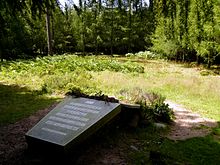Air Inter flight 148
| Air Inter flight 148 | |
|---|---|
|
The crashed plane |
|
| Accident summary | |
| Accident type | Controlled flight into terrain |
| place | near Mont Sainte-Odile |
| date | January 20, 1992 |
| Fatalities | 87 |
| Survivors | 9 |
| Aircraft | |
| Aircraft type | Airbus A320-100 |
| operator | Air Inter |
| Mark | F-CHED |
| Departure airport |
|
| Destination airport |
|
| Passengers | 90 |
| crew | 6th |
| Lists of aviation accidents | |
On January 20, 1992, an Airbus A320 crashed on Air-Inter flight 148 in the Vosges near Mount Odile . The scene of the accident is on the mountain La Bloss (height 826 m). In the accident, 87 of the 96 inmates were killed.
Belgian molecular biologist and entrepreneur Jean-Pierre Lecocq was among the dead .
the accident
On January 20, 1992 at 7:20 p.m. the Airbus A320-111 ( aircraft registration number : F-GGED) of the French airline Air Inter hit the neighboring mountain "La Bloss" (height 826 m) during the approach to Strasbourg airport south of the Odilienberg on. The machine was on a scheduled flight from Lyon-Satolas Airport to Strasbourg . Because Air Inter did not equip the aircraft with a Ground Proximity Warning System (GPWS), the pilots were not warned of the impending impact. The accident occurred at night, in fog or in low clouds and light snowfall.
Only after four and a half hours was the wreck found by the rescuers. The investigation into the cause of the crash was made more difficult by the fact that the flight data recorder (FDR) could no longer be read due to heat damage.
causes
The pilots used the A320's computer system, which was still quite new at the time, incorrectly and mixed up the mode when programming the autopilot . Entering the number "33" - for the correct glide angle ("-3.3 degrees") when programming the autopilot in TRK / FPA (track / flight path angle) mode - was therefore carried out by the computer in the HDG / V / actually set. S (heading / vertical speed) mode interpreted as the rate of descent ( "-3,300 feet per minute" ). In both modes, the display showed the digits “33” in large, which were only separated by a tiny point for the glide angle mode. But normal would only have been around 800 feet per minute.
Accident investigators stated that it was not just this one pilot error, but a chain of errors and unfortunate events that led to the crash. The pilots were falsely warned by air traffic control that they were to the right of the runway to be approached, even though they were to the left of the runway due to a vector incorrectly passed on by air traffic control , which put an additional burden on the crew. When the flight with the too high rate of descent was simulated in the flight simulator , the aircraft did not collide with the mountain at first. Further investigations revealed that the moment the wrong rate of descent was entered into the autopilot, the aircraft got into small turbulence , which triggered a safety function of the autopilot which led to the rate of descent being increased further.
consequences
In the criminal trial before the tribunal correctionnel in Colmar in 2006, six people were charged - employees of the airline, the aviation safety authority and Airbus - all of whom were acquitted on November 7, 2006. There was also criticism of the long delays in the rescue measures by the French military, which only found the crash site after four and a half hours following information from civilians. It is assumed that if the rescue workers had arrived earlier, more passengers would have survived, while they died of hypothermia in freezing temperatures (−2 to −10 ° C).
The final report of the investigation committee explicitly criticized the cockpit design of the aircraft. This led to an improvement in terms of displaying the glide angle with two digits and the rate of descent with four digits. In addition, the VOR antenna of the A320, which could lead to incorrect displays in the cockpit due to excessive metal shielding, was changed as a result of the accident. In the technical equipment of aircraft, the design of the flight recorders was changed so that they can withstand higher temperatures for a longer period of time.
Similar incident
- Indian Airlines flight 605 , on which an Airbus A320 crashed in 1990 approaching HAL Bangalore International Airport, also due to incorrect operation
Web links
Individual evidence
- ↑ Aviation Safety Network: Air accident 20 JAN 1992 of an Airbus A320-111 F-GGED - Strasbourg-Entzheim Airport (SXB)
- ^ Report of the investigative commission (French, including photos of the scene of the accident) ( Memento from September 23, 2015 in the Internet Archive )
- ^ The Final Blow / Tragedy in Alsace , Mayday - Alarm in the cockpit
- ↑ Report of the investigative commission (French) ( Memento of 23 September 2015 in the Internet Archive ), Section 116.22, 45.3 ( “L'analysis a mis en lumière un certain nombre d'imperfections dans les dispositifs de recherches préétablis…” ) and 45.4 (... certaines améliorations du dispositif de secours devraient être étudiées)
- ↑ Report of the Commission of Inquiry (French) ( Memento of 23 September 2015 in the Internet Archive ), Sections 32.7 and 4.4 ( RECOMMANDATIONS RELATIVES A L'ERGONOMIE DE L'INTERFACE AVION-EQUIPAGE )
Coordinates: 48 ° 25 ′ 31.6 ″ N , 7 ° 24 ′ 19 ″ E

